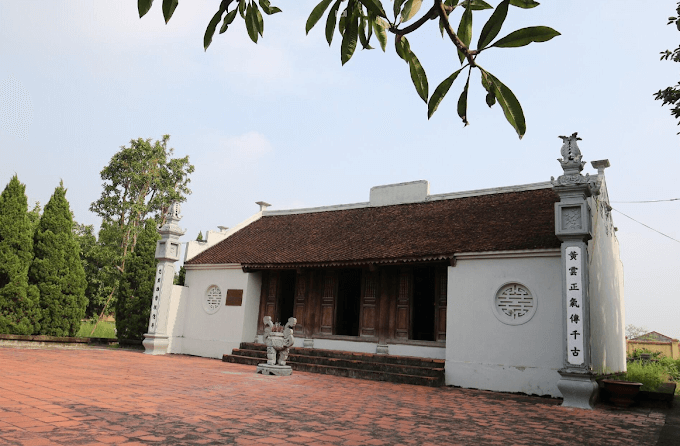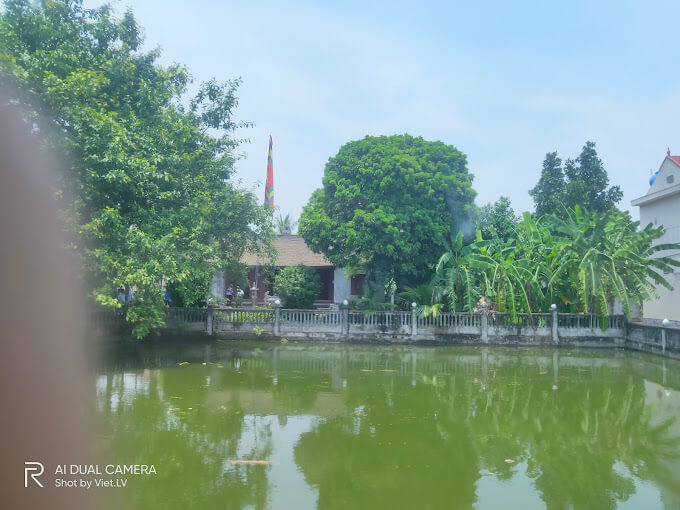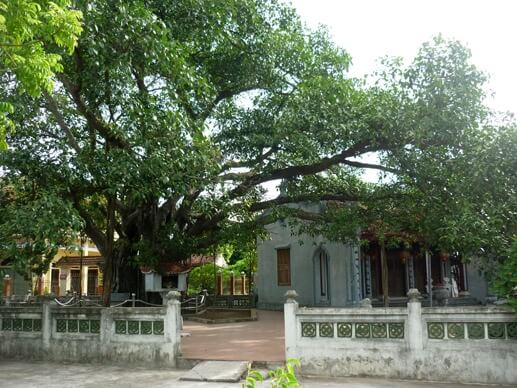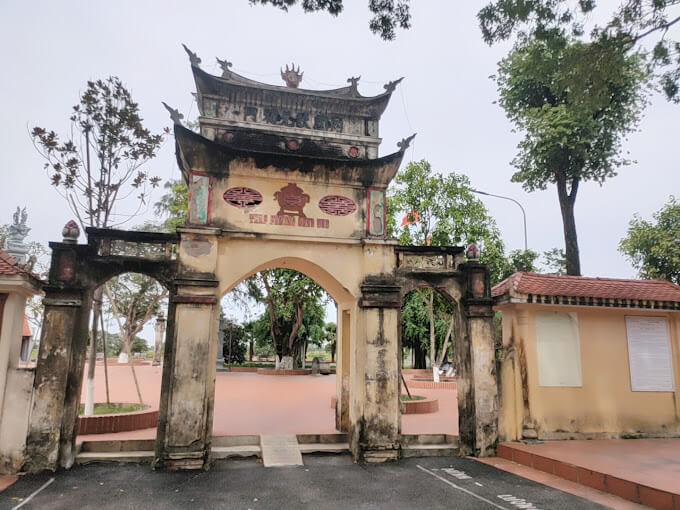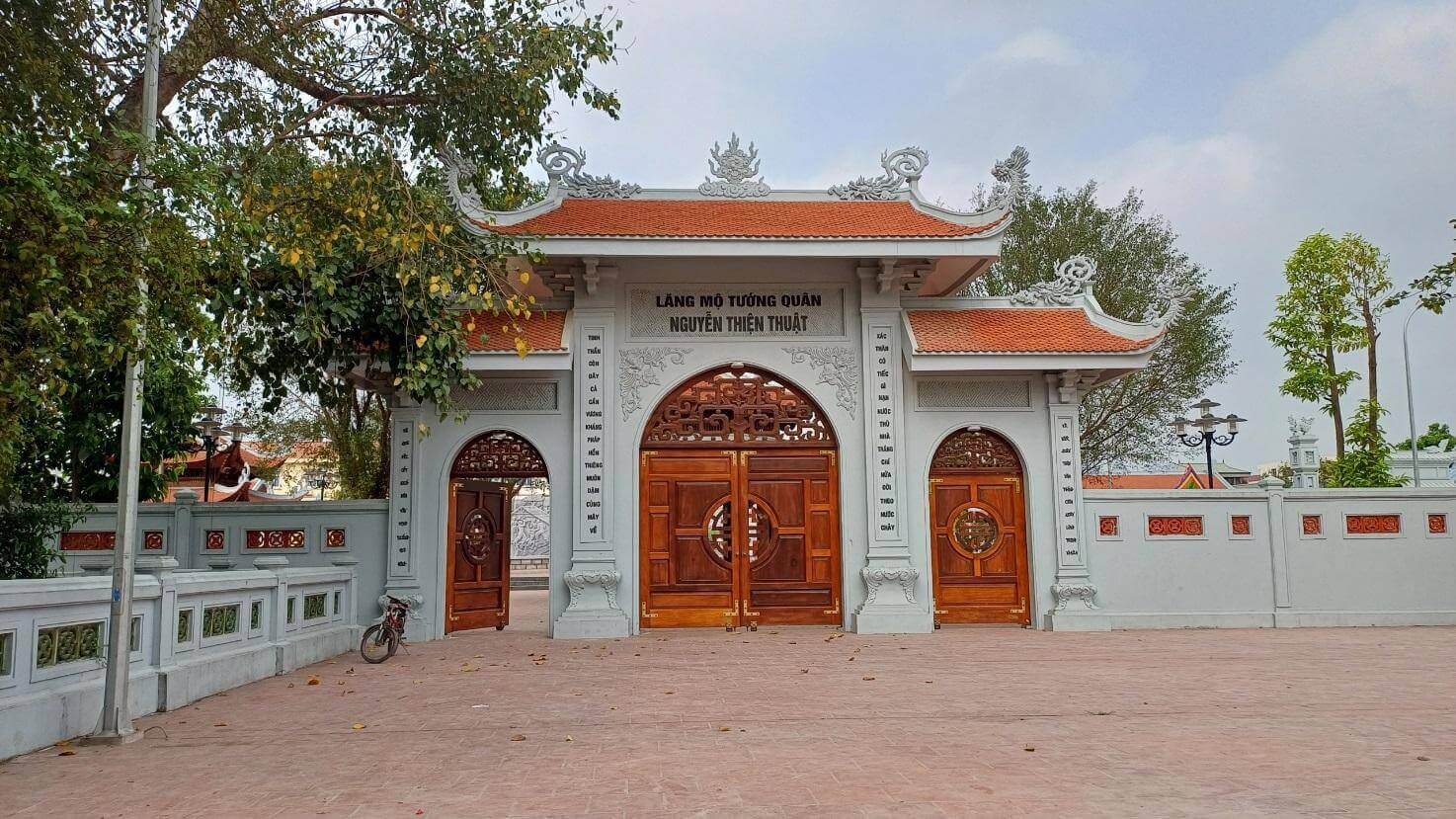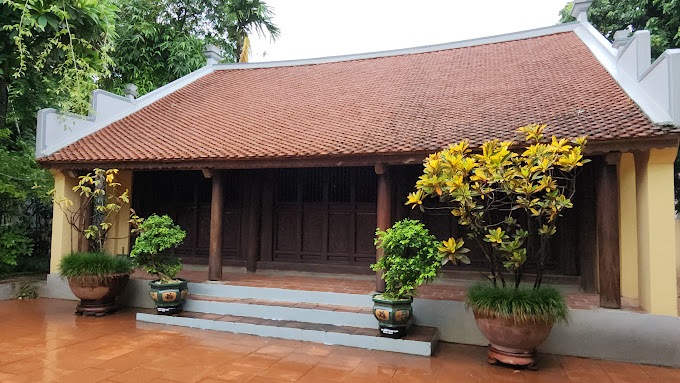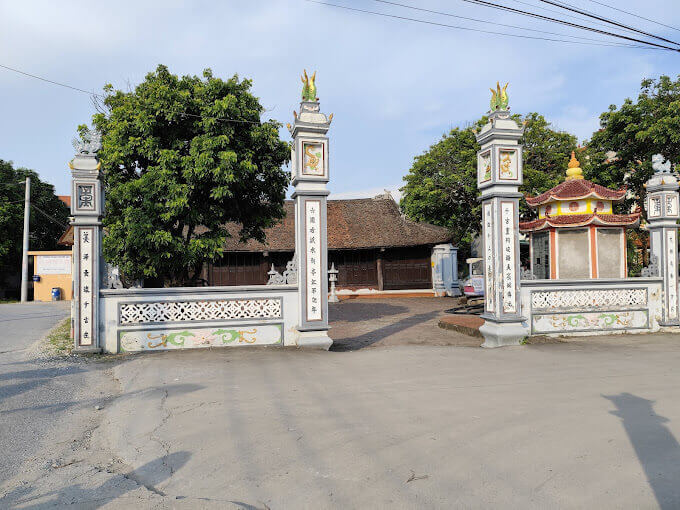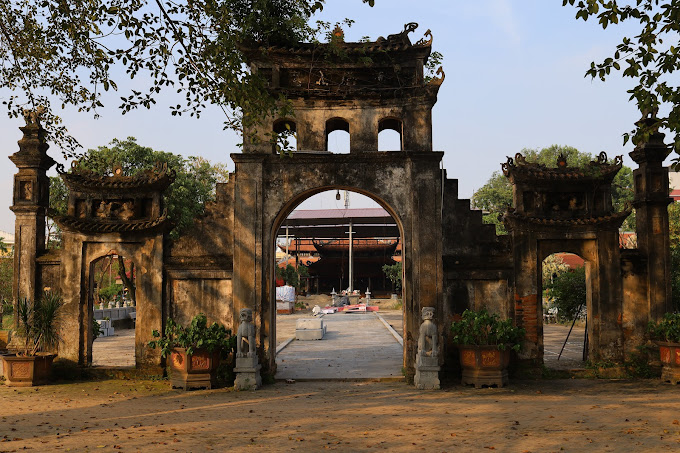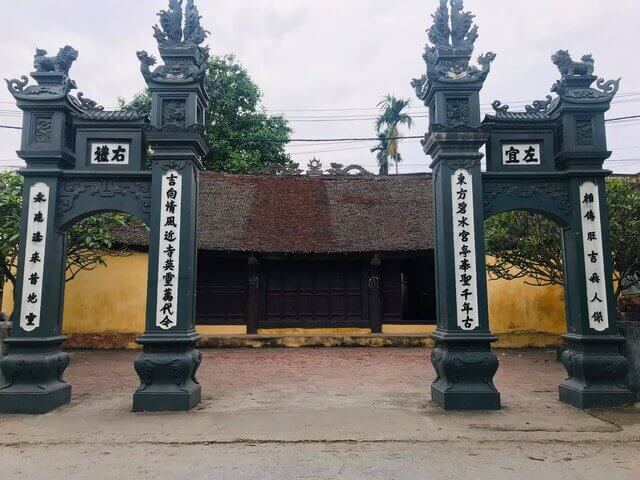Relic point Vietnam
Việt NamMemorial House of Mrs. Hoang Thi Loan (Uncle Ho's Mother)
Ms. Hoang Thi Loan - President Ho Chi Minh's mother was born in a land rich in revolutionary tradition and studiousness; The Hoang family's original hometown is in Van Noi village, Hong Tien commune, Khoai Chau district. In her, she brings together the noble qualities of a traditional Vietnamese woman: responsible, kind, compassionate, hard-working, and devoted to her husband and children. To pay tribute and honor her great contributions, in 2003, the People's Committee of Hung Yen province decided to start construction of a church (now the Memorial House) on the land of Van Noi village, Hong Tien commune. This is a project with bold traditional architecture, in harmony with the space and landscape of the Northern Delta village, in the old campus of Van Noi communal house. Inaugurated in 2005, this is one of the important works of the province, a place for people from all walks of life inside and outside the province to offer incense, visit, and commemorate the woman who sacrificed her life for her husband, children, and family. dedicating to the Vietnamese people a great son - the much beloved President Ho Chi Minh. On July 26, 2023, the Chairman of Hung Yen Provincial People's Committee signed a decision to classify Mrs. Hoang Thi Loan Memorial House as a Provincial Historical Relic under No. 1555/Decision - Chairman of the People's Committee. After 20 years since construction, some items of the project have deteriorated. With the attention of provincial leaders and departments, branches, in early 2024, Khoai Chau District People's Committee implemented the Project to restore and embellish Mrs. Hoang Thi Loan Memorial House and auxiliary works, including Items: Restoration and embellishment of Memorial House relic items; renovating and upgrading the road to the Memorial House and a number of other items... After 6 months of construction, up to now, the work of restoring and embellishing items and auxiliary works of Mrs. Hoang Thi Loan Memorial House has been completed. complete. Relics of the Memorial House of Mrs. Hoang Thi Loan, making this place a red address, an attraction for visitors to learn about history... Source: Department of Culture, Sports and Tourism.
Hung Yen 3940 view
Communal house - Temple in Mao Xuyen village
Based on the preserved legends and ordinations, Mao Xuyen Village Communal House was built to worship the Village God, Mr. Hoang Van Lang, also known as Duc Hoang Hai, the second son of female general Ngoc Chi during the Hai Ba Dynasty. Trung were the people who had the merit of expelling the Southern Han army in the years 40 - 43 AD. The communal house has a "first, last, last" architecture. Currently, the communal house still retains two ordinations and precious artifacts such as stone stele, great paintings, parallel sentences, hammock doors and a system of worship statues. Behind the communal house is the pagoda, a place to worship Shakyamuni Buddha, with Dinh script architecture with many ancient features still preserved such as Tam Quan, front hall and upper palace. During the resistance war against the invaders, Mao Xuyen Communal House - Pagoda was also a place for revolutionary activities of local pre-uprising comrades. With that historical meaning and value, at the ceremony, authorized by the Chairman of the Provincial People's Committee, comrade Mai Xuan Gioi, Deputy Secretary of the District Party Committee - Chairman of the District People's Committee, awarded the provincial-level relic ranking certificate Dinh- Mao Xuyen Village Pagoda for officials and people of Nguyen Trai commune. Source Electronic information portal of An Thi district, Hung Yen province.
Hung Yen 3546 view
Banyan tree and La Tien Temple
Historical relics Banyan Tree and La Tien Temple are located in Nguyen Hoa commune (Phu Cu, Hung Yen). This is a place to commemorate the heroic souls of 1,145 heroic martyrs, revolutionary soldiers and our compatriots who were killed by the French colonialists during their occupation here (from 1949 - 1954), including 121 officers and soldiers. People of Nguyen Hoa commune (Phu Cu, Hung Yen). During the resistance war against the French colonialists, La Tien was an area with an important strategic military position, blocking the south of Hung Yen, the north of Thai Binh and the west of Hai Duong, so the enemy took this as an occupation position. , set up posts and blockades to prevent the reinforcement of human resources, material resources, weapons, guns, ammunition, food, etc. from neighboring areas and suppress the revolutionary movement of Hung Yen's army and people. Right from the beginning of the occupation, the enemy terrorized the country in an attempt to establish an extremely brutal "white belt". They captured thousands of people and guerrillas in the area and took them to La Tien post to brutally torture and kill them in barbaric ways. In just nearly 5 years of occupation in La Tien (1949 - 1954), the enemy killed 1,145 revolutionary soldiers and patriots. But the enemy's brutality not only failed to suppress the revolutionary movement, but also fanned the flames of hatred and the stubborn will to fight for independence and freedom of our army and people. The attack to destroy La Tien post conducted by our army and people at the end of January 1954 contributed to the resounding victories of the army and people of Hung Yen province in the resistance war against the French colonialists; of great significance on the battlefield across the country, contributing to weakening the enemy, creating conditions for our army and people to win Dien Bien Phu. With special historical values, the Banyan Tree and La Tien Temple have been recognized as National Historical Sites according to Decision No. 4007/Decision - Ministry of Culture, Information and Tourism dated November 18, 2015 of the Ministry. Culture, Sports and Tourism. Today, this relic has become a symbol of the resilient, indomitable and rebellious spirit of the people of Phu Cu in particular, the people of Hung Yen and the whole country in general. This place is not only a place to set up hate stele and engrave the crimes of the enemy, but also a place to pay tribute to the soldiers and compatriots in the province and neighboring provinces who sacrificed heroically to protect every inch of land. , the hometown river. This place has also become a red address to educate the young generation about revolutionary traditions, patriotism, heroism, and resilience of our officers, soldiers, and compatriots. Electronic information portal of Phu Cu district, Hung Yen province.
Hung Yen 3440 view
Tong Tran Temple
Tong Tran Temple is located in a prime location, on high and open land in the south of An Cau village, Tong Tran commune, Phu Cu district, Hung Yen province. Tong Tran Temple has the original name "Tien Can Linh Tu", the common name is Thuong Temple, Quan Trang Temple, people often call it Tong Tran Temple. Legend has it that the temple was built on the foundation of Tong Tran's old house from the Ly dynasty. The temple is located separately from the residential area on a campus of about 5 acres in the North. In 1950, the temple was destroyed. After many restorations, in 1998, Tong Tran temple was renovated beautifully. Tong Tran Temple has a two-story, eight-roof architectural gate. The ancient part of the match is inscribed with the Chinese characters "Luong Quoc Trang Nguyen tu mon" (the gate of Luong Quoc Trang Nguyen temple). In the middle of the yard is a scroll-shaped stone gate carved and crafted meticulously and delicately, with content praising the beauty of the temple in Chinese characters. With the principle of "When air meets wind, it spreads, when it meets water, it stops" in feng shui, the "dragon eye pond" in front of the relic's yard has clear blue water all year round, meaning it is a water gathering point, bringing prosperity. prosperity for all people in the village. The relic has a Nhi-shaped architecture, following the ancient architectural style, including two sacrificial buildings and a harem. The front altar consists of 3 rooms and 2 wings made in the style of a gable wall. In the middle of the roof line is a tiger head with the word Tho in its mouth and a pair of moon faces, with two dragons flanking the moon on both sides. The three front altars have carved flower and leaf images and written Chinese characters on the three front altars. In the Pre-Saint space, the floor at the 2 gable ends is 45cm higher than the base of the 3 middle spaces. The column base system is a ball-shaped platform. Supporting the roof are sets of trusses structured in the style of gong racks. The components are smoothed and sharpened, creating a strong and stable appearance for the temple. In the middle is the Council altar, above the altar are 3 gilded lacquered hammock doors, above the hammock door is the Chinese character "Luong Quoc Trang Nguyen". The room on the right hangs a scroll, the room on the left is a brooch written in Chinese characters, with elegant, sharp handwriting, inscribed with 8 verses praising the beauty of the land as well as the bright, airy space of the temple area. . The harem has a gable wall architecture, consisting of 3 rooms and 2 wings. The structure is two sets because the middle has a gong stand-style architecture. In the middle of the star anise is a tiger head with the word Tho and surrounded by flower strings. The remaining ends all touch a stylized dragon's head with an upside-down sword and spear. This way of creating has both a load-bearing and decorative effect, somewhat reducing the roughness of architectural structures. The middle space of the harem is where the coffin and statue worshiping Trang Nguyen Tong Tran are placed, the two side rooms are the thrones worshiping Duong Tam Kha and Doan Thuong. In the relic grounds, in addition to the main worship area, there is also the Mother Temple, which is a place to worship Mrs. Cuc Hoa, Tong Tran's gentle wife. She was also the one who took care of his mother for 10 years when Tong Tran was on a mission. The new Model House was rebuilt in recent years on the old foundation with simple architecture. The building has a Dinh-shaped architecture consisting of two altars and a harem. The altar consists of three rooms and two left, with a simple truss-style architecture. The components are smoothly planed and sharpened without engraved patterns. The middle space is where the statue of Mrs. Cuc Hoa is placed. To commemorate the merits of talented people, every year the Tong Tran temple festival is held from the 10th to the 17th of the 4th lunar month, of which the 13th and 14th are the main festival days. With historical, cultural, architectural and artistic values, Tong Tran Temple has been recognized by the State as a national historical relic according to Decision No. 2387/Decision dated December 30, 1991. Source Electronic information portal of Phu Cu district, Hung Yen province
Hung Yen 3496 view
Temple and mausoleum of General Doan No
The temple worshiping General Doan No is located on a campus of more than 1,000 m2 in Phuong Trung village, Phuong Chieu commune (Hung Yen city). The land here is good, the trees are green in all four seasons. Senior General Doan No was the founder of the country during the Later Le Dynasty. He was a talented general of Le Loi, who had great contributions in the Lam Son uprising against the Ming army in the 15th century. He originated from a fairly ancient clan in Ke Nua village (now in Trieu Son district, Thanh Hoa province). He was born in 1393, the second child of Mr. Doan Quyet - who passed the third exam to become a palace doctor during the Tran dynasty. In the year of At Mui (1415), the Ming enemy massacred the Nong Cong area, killing more than 3,000 people. In Ke Nua alone, only 18 people escaped, including his two brothers. In 1416, Doan No returned to Le Loi, participating in the Lung Nhai oath ceremony and the Lam Son uprising. He was one of Le Loi's first generals. In 1425, Le Loi sent general Doan No along with military officer Tran Nguyen Han to persuade the people, bringing 1,000 troops to attack the South, liberating Tan Binh and Thuan Hoa citadels (belonging to the provinces from Quang Binh to Thua Thien). Hue today) to expand the area, forcing the Ming army to retreat into the citadel. From then on, the Lam Son insurgent army had a solid rear base and advanced to counterattack to the North to liberate Thang Long. After the successful resistance war against the Ming army, when considering his merits and rewards, he was appointed by King Le Thai To as a Lieutenant General, a General of the Left, with the title Dai Tri Tu. Afterwards, he was awarded the title of Tru Quoc Cong Thuong General in charge of Son Nam. He was given a village in Huong Chieu village, now Phuong Chieu commune. He brought his whole family from the capital to Huong Chieu, forming the Doan family in Hung Yen. The temple of General Doan No was built right after his death (1439). In the past, the temple and mausoleum of Senior General Doan No was just a small temple with Dinh script architecture. Over time, the temple was restored and embellished to become larger and more beautiful. Currently, the temple has a Tam-shaped architectural structure including the Pre-Temple, Central Tu and Rear Palace. The altar consists of 5 rooms made of ironwood, built in the ancient style, with four pillars filled with lotus-filled boats and carved flowers and leaves. In the center of the altar room is the great pagoda "Tran Gia Vu Liet" below which there is an incense altar and a 19th century sculpture. On both sides are parallel sentences (Le dynasty, Thai To discovered Nam Son Loi Dai Hien - Founding the country's god Doan outstanding general and hero). For the Trung Tu court, a shrine was placed to worship Doan No's father, Mr. Doan Quyet, and his mother, whose family name was Nguyen. In the most solemn position of the Harem Palace, there is a statue worshiping Senior General Doan No. The items are relatively solid, meeting the spiritual belief needs of Doan family descendants and local people who come to worship and show gratitude and respect to their ancestors. 500m from the temple is the tomb of Senior General Doan No. The mausoleum was built on the land "Figure of a dragon drinking water" (shaped like a dragon drinking water) with the position of Thanh Long on the left and White Tiger on the right. His tomb is located on a high mound, surrounded by fields. The mausoleum has an area of 16 m2 and is built with 2 floors and 8 roofs. The front of the mausoleum embossed the words "Doan No Cong Than". Next to the mausoleum is a post-commission stele recording the life and career of General Doan in the national language so that future generations can pay their respects and commemorate a typical famous general of the Le Dynasty who was worshiped by the whole country. Through many changes in history, up to now, the temple of General Doan No still preserves many valuable artifacts, typically the genealogy book of the Doan family in Phuong Chieu, the genealogy book of the Doan family, a genealogy book of the Doan family. Ordination of the Le Dynasty, great paintings, couplets and statues of Senior General Doan No... Although the number of artifacts is not large, they have made an important contribution to the study of the country's history, the history of famous people and the history of the village. commune and family blood relationships. Besides, some artifacts and worship objects also enrich the traditional art of the nation. Every year, at the beginning of spring, local people and the Doan family hold a festival in mid-January to commemorate General Doan No. With typical and unique values, the temple and the mausoleum of General Doan No were ranked as national historical relics on April 20, 1995. Source: Department of Culture, Sports and Tourism
Hung Yen 3484 view
Nguyen Thien Thuat memorial area
Nguyen Thien Thuat (1844 - 1926), pseudonym Manh Hieu, from Xuan Duc village, Bach Sam district, Duong Hao district (now Xuan Dao village, Xuan Duc commune, My Hao town). Born in a poor Confucian family, in 1870, Nguyen Thien Thuat passed the baccalaureate. In 1874, he was instrumental in suppressing the enemy in Kinh Mon prefecture (Hai Duong) and was appointed as the state regent. In 1876, he passed his bachelor's degree and held the position of governor of the Tu Son government. He worked as an honest, fair, civil and martial mandarin. In the year of the Cat (1879), he held the position of Tan Tuong Quan, and in 1881, he held the position of Huong Hoa Son, Chief Minister of the Office, and Tan Tuong Quan, Deputy Commander of Son Tay province. Therefore, at that time he was called Tan Thuat or Tan Dong (because he was from Eastern province). When the French colonialists invaded Tonkin, Nguyen Thien Thuat twice resisted royal orders, determined to fight the French. The first time, he retreated to Dong Trieu, often contacting Dinh Gia Que - leader of the Bai Say insurgent army, recruiting and developing insurgent forces in the delta. On November 12, 1883, Nguyen Thien Thuat's insurgent army attacked Hai Duong province to surround the enemy, but the force was still weak, so he had to retreat. The second time at the end of 1883, after signing the Harmand treaty, the court continued to make concessions to the French colonialists, dismissed troops in Tonkin and required mandarins to return to the capital to wait for instructions. Nguyen Thien Thuat brought The army went to Hung Hoa (Tuyen Quang) with Nguyen Quang Bich to defend the citadel. In March 1884, Hung Hoa citadel fell, he and a number of generals determined to stay and fight against the French. After Lang Son citadel fell (March 1885), Nguyen Thien Thuat fled to Long Chau (China) to prepare forces to continue fighting. In July 1885, King Ham Nghi issued Can Vuong decree, Nguyen Thien Thuat returned to the country to establish Bai Say base, led the uprising against the French, continuing the career of the Dinh family (at this time Dinh Gia Que had passed away). ). King Ham Nghi conferred on him the title "Bac Ky Hiep Thong Military Mandarin Gia Chan Lieutenant General", the people also called him Mandarin Hiep Thong, and many talented generals followed him. Bai Say was a particularly strategically important area in the Red River Delta at that time. With such a prime location, right from the time the French army invaded the Tonkin provinces (1883), Bai Say was built into a base against the French colonialists of the Dinh Gia Que insurgent army. Since 1885, based on the base area that the Dinh family had previously built, with the strategic vision of a military man, Nguyen Thien Thuat continued to expand the Bai Say base area to almost every government and district. of Hung Yen and Hai Duong provinces, including Khoai Chau, Van Lam, Van Giang, My Hao, Yen My,... With the wise leadership of Nguyen Thien Thuat, the Can Vuong movement on Bai Say land quickly broadcast developed in all aspects, becoming one of the largest anti-French centers at the end of the 19th century in Tonkin. In 1888, Hoang Cao Khai sent troops to suppress the movement, using Dong Khanh's name to bribe and persuade Nguyen Thien Thuat to surrender and promise to restore his title. Nguyen Thien Thuat wrote in this document the four words "Bat khang thu chi" (Refuses to accept instructions). Afterwards, he handed over power to his younger brother, Nguyen Thien Ke, to continue maintaining the uprising, going to China with the policy of asking for aid to strengthen anti-French forces. During the rest of his life in China, Nguyen Thien Thuat often contacted Ton That Thuyet and a number of comrades, including Nguyen Chi Thuong, his second son. Later, Thuong was captured and sent to Con Dao. He, together with Foreign Marquis Cuong De and Phan Boi Chau, went to Dong Kinh to establish the "Vietnam Duy Tan Phuc National Assembly" with the purpose of finding ways to liberate the nation, expand people's knowledge, and create conditions to bring Vietnamese students abroad. studying abroad,... Nguyen Thien Thuat died on May 25, 1926. His grave is located on a hill in Quan Kieu village, on the outskirts of Nanning city, Guangxi province (China). The tombstone is engraved with the words "Vietnam revolution. Late General Nguyen Cong Thien Thuat - Tomb. On January 30, 2005, his remains were moved to be buried in Xuan Duc commune, My Hao district, Hung Yen province. General Nguyen Thien Thuat's memorial area is located on Xuan Nhan land - where the forward guard post of the old Bai Say insurgent army was located, with a total area of 1621.9m2, including many items: gate, memorial house, house. stele, grave of General Nguyen Thien Thuat and relief wall. The Bai Say Uprising (1885 - 1892) was the largest, longest-lasting and most resonant uprising in the Northern Delta region during the "Can Vuong" movement against the French colonialists at the end of the 19th century. The uprising lasted a decade, going through three stages, associated with the names of three leaders: Dinh Gia Que, Nguyen Thien Thuat and Nguyen Thien Ke. But it can be affirmed that Nguyen Thien Thuat is the most typical leader, the soul of the Bai Say uprising. With the above values, Nguyen Thien Thuat Memorial Area, Xuan Duc commune, My Hao town, Hung Yen province has been ranked a national historical relic by the Minister of Culture, Sports and Tourism in Decision No. 3077/Decision - Ministry of Culture, Sports and Tourism dated October 27, 2020./. Source Department of Cultural Heritage.
Hung Yen 3541 view
To Hieu memorial area
To Hieu was born in 1912, the youngest child in a family with a tradition of academics and patriotism. His great-grandfather, Doc Nam To Ngoc Niu, was praised as one of the three exemplary teachers of contemporary Tonkin. His father was Mr. To Y, his mother was Mrs. Ngo Thi Ly - daughter of Mr. Ngo Quang Huy, former Director of Bac Ninh, one of the key leaders of the Bai Say uprising movement at the end of the 19th century. From a young age, To Hieu proved to be intelligent and had great ambition. His father passed away early, and his mother and eldest son, To Tu, had to work hard to raise their five brothers. To Hieu was sent to study at Hai Duong primary school for boys. In 1926, when he was only 14 years old, To Hieu participated in the mourning movement for patriot Phan Chu Trinh and was expelled from school. His eldest brother continued to send him to Hanoi to study. During the period 1927 - 1929, To Hieu and his cousin To Gi were admitted to the Xich Ve Doan organization - a student youth organization led by the Revolutionary Vietnamese Youth Association - the Party's predecessor organization. During this time, To Hieu actively participated in the association's activities such as rallies, banner-raising demonstrations on major international anniversaries, and also had the task of protecting the protest group and other organizations. comrade leader. In 1930, while on a fundraising campaign trip, To Hieu was followed by secret police, arrested and sentenced to 4 years in prison and exiled to Con Dao. It was here that he and his brother To Chan were honored to be admitted to the Indochina Communist Party at the age of 18. To Hieu was trusted by senior communists such as Ton Duc Thang and Ngo Gia Tu, who cared about guiding and honing the bravery of young Party members. In 1934, after completing his prison term, To Hieu was released and placed under house arrest in his hometown of Xuan Cau village. Overcoming the siege and surveillance by French secret police, To Hieu not only participated in leading the patriotic movement, raising people's knowledge, gathering the masses in his homeland, but also sought to coordinate with loyal comrades to restore restore the Northern Region Party Committee. At the end of 1936, at a meeting at comrade To Hieu's rented house on Hang Bot street (Hanoi), including comrades Hoang Van Non, Hoang Quoc Viet, Truong Chinh, To Hieu, Nguyen Van Minh, Luong Khanh Thien, Tran Quy Kien officially restored the Northern Party Committee after years of revolutionary decline and broken Party organizations. At the meeting, To Hieu was elected as a Standing Member of the Party Committee, in charge of propaganda, training workers and directly participating in leading public work and activities in Hanoi (at this time Hanoi did not have a City Council). committee). At the end of 1938, To Hieu was appointed by the Central Committee to be Secretary of Inter-Region B, including the Northern coastal provinces of Hai Duong and Hung Yen; Special Secretary of Hai Phong. In December 1939, To Hieu was arrested by French secret police at the City Party Committee's printing facility. Although his thin body was tormented by tuberculosis when he was exiled in Con Dao prison, and was tortured and bribed, with the steadfast spirit and determination of a communist, he overcame all challenges. fierce challenge. The comrade was sentenced to 5 years in prison and exiled to Son La prison in early 1940. In early 1944, To Hieu's health was almost exhausted, but with an optimistic spirit, To Hieu told his brothers in the cell. : "I know for sure that I will die sooner than others, so I have to take advantage of the time to fight and serve the Party." A few days before he breathed his last, To Hieu asked comrade Hoang Tung to write down a will for the Son La Prison Cell, advising his brothers to stay and maintain their fighting spirit, clearly analyze the world situation and in the country, the inevitable victory of the Revolution. He breathed his last on March 7, 1944 in the mourning of all comrades and compatriots. Revolutionary To Hieu sacrificed his life, but To Hieu's spirit is forever immortal and has become a precious spiritual heritage of the Party and nation, the pride of descendants, as well as people throughout the country. The story of the To Hieu peach tree at Son La prison has entered the pages of books and is considered a symbol of revolutionary optimism. To Hieu Martyrs' Memorial House was built in 2000, at the same time as the construction and renovation of Doc Nam To Thi Tu Duong (the To family church of Doc Nam To Ngoc Nuu). Comrade To Hieu Memorial House The memorial house consists of 3 front rooms and 1 back room, made of four iron wood; The sets are made in the form of a lotus-shaped frame combined with a gong-shaped truss structure, creating a spacious interior space. The main decorative themes are traditional leaf patterns, mainly on the two sets of gables and on the lotus joints on the pillars. The back room is decorated with an altar with a photo and statue of comrade To Hieu. The entire inner sanctum of the church's three compartments is used to display precious artifacts and images about Comrade To Hieu's career and active life, arranged from left to right according to 3 themes: Homeland Xuan Cau and his family, the To family of Xuan Cau village; Biography and revolutionary activities of comrade To Hieu; The feelings of the leaders of the Party, State and people towards comrade To Hieu. To family church of Mr. Doc Nam - To Ngoc Nuu Located on the same site as the Comrade To Hieu Memorial House, the entrance gate is built with bricks, in the traditional style, with a pair of Chinese parallel sentences embossed on both sides of the gate pillars. Their church building is designed and built with wood according to traditional architecture; Northeast direction overlooking Nghia Tru River - an ancient tributary of the Red River. The site of Tu Duong has the most typographic architecture, built in the style of gabled walls, and the roof is covered with yin and yang tiles. The inside of the house is divided into 5 compartments, the door system is made of a table top style, following the upper and lower panels; The structure of the trusses is made of four sets of wood in the style of dou-lotus; Decorative themes mainly focus on the gables and the pillars on the armpits in the two gables with the themes of bamboo/dragon-shaped apricot, fighting cocks and on the husbands, the ends of the armpit beams touch lotus petals, soft leaf pattern. The middle space of the church is where the altar is placed, inside are placed 4 tablets of deceased ancestors of the To family. On the right side hangs the great letter 壽春 (Xuan Tho) given by Mr. Doc Nam's students to celebrate his birthday in the year of the Goat (1871). In the middle of the yard is a peach tree extracted from the To Hieu peach tree in Son La prison donated by the Son La Provincial Party Committee in 1998. With the above values, To Hieu Memorial Area, Nghia Tru commune, Van Giang district, Hung Yen province has been ranked as a National Historical Site by the Minister of Culture, Sports and Tourism in Decision No. 3080 /Decision - Ministry of Culture, Sports and Tourism dated October 27, 2020./. Source Department of Cultural Heritage.
Hung Yen 3281 view
Sam Khuc Communal House
Sam Khuc communal house (also known as Cham communal house) belongs to Viet Hung commune, Van Lam district, Hung Yen province. Based on the legends, ordinations, and declarations of Elder Huong and Ly, the translator of Sam Khuc village (formerly My Trach village) collected by the Institute of Ancient Far East in 1938, is currently kept at the Research Institute. Han Nom and Hung Yen Provincial Library and the stories of the elders in the village, Sam Khuc Communal House is the place to worship the village's Tutelary God Pho Cuu Dai Vuong (Hung Vuong King's reign), whose merits helped the kings defeat the enemy. set establish order in the country and bring a prosperous life to the people. On the first sentence of the Great Pagoda, there is written the absolute date of the year the communal house was built: "Duy Tan Nham Ty, year of the year, smell of moon, gradually approaching Sun Luong, time of residence, Thuong Luong Dai Cat" (August 6th, year of Nham Ty (1912), Duy's era name). Tan Truong Thuong Luong is good). Based on the existing ordinations, including the earliest ordination in the 10th year of Tu Duc (1856), it can be known that Sam Khuc communal house existed before that time. Sam Khuc Communal House was built on a high, open area of land, with the front facing southwest. The communal house has a Dinh-shaped floor plan. Looking from the outside, in front of the communal house is a lake, between the lake and Nghi Mon is a village road running through. Through Nghi Mon is a large yard, in the innermost part is the architecture of the majestic and majestic Great Court and the Harem. The structures and architectural components are all made of four-stone wood, imbued with the Nguyen Dynasty's artistic style and are still consistent and solid. The ritual gate is made in the style of four pillars (lanterns) forming 3 doors. The Dai Bai Court is the item with the largest area at Sam Khuc communal house, including 05 compartments made in the style of gable walls with dimensions of 19.3m long, 10.17m wide, 6.4m high (from the roof to the floor). family). All four sides around the Dai Bai foundation are lined with bricks, 0.65m high above the communal house yard, covered with mortar on the outside. The foundation is firmly reinforced. The floor is tiled (30cm x 30cm), with a square pattern. From the yard, there are brick steps leading up to the Dai Bai porch. Dai Bai's architectural structure includes 6 sets of rafters, with 24 wooden columns (12 main columns, 12 military columns), with 4 rows of column bases. The distance between the front column and the rear column is 4.22m, the main column and the military column is 2.05m. The columns stand on green stone bases without decorative patterns. Supporting the roof of the Dai Pagoda are the roof beams and armpit beams. The roof system of Sam Khuc Dai Bai communal house is all made in the style of "hidden piles of beams and pillars". The armpits of the Dai Bai communal house are crafted in two forms: "semi-stacked beams" in the side compartments and "con me" in the middle compartment. The Harem Court is an item consisting of 03 compartments, located parallel to the Great Pagoda Court, made in the style of a gable wall, measuring 7.9m x 7.1m (the distance between the two main columns is 2.8m; the main column is 2.8m). the one to the army column is 1.67m). The Harem Center is where the altar to worship the village's Tutelary God Pho Cuu Dai Vuong is located. Tiled floor 20cm x 20cm, public letter pattern. The foundation is lined with red bricks covered with mortar. The special thing about Sam Khuc village's rear palace is that it still retains part of the wooden floorboard architecture of the ancient communal house. The harem has a structure of 4 rows of columns with 6 main columns and 10 military columns (main columns have a diameter of 300mm, military columns have a diameter of 250mm). Supporting the roof diaphragm are the ridge beams, armpit beams and a system of wooden columns placed on the base of the platform. The harem has 03 sets because the roof is made in the style of "stacking the beams", not decorated with patterns. The carvings here focus on architectural components, creating the perfect beauty of the building, bearing the main artistic style of the Nguyen Dynasty with many rich and diverse decorative themes, making the house unique. The house became lively and achieved the highest architectural and artistic value in the art of the Nguyen Dynasty. In particular, the image of the four sacred animals with dragons is the main element in the carved panels, in addition, there are also decorations such as the four sacred animals, four precious animals (pine, chrysanthemum, bamboo, apricot), flipped leaves, clouds, and flowers. Tho script,... Sam Khuc communal house is a unique architectural work, which preserves many precious relics of both tangible and intangible culture. Almost all architectural structures and components are densely carved with rich and diverse decorative themes representing mascots and plant patterns in motion. Currently, Sam Khuc communal house still preserves rare and valuable relics and antiques: miracles, great characters, scrolls, ordinations, bronze bells, thrones and tablets, hammock doors, palanquins, etc. .In addition to material vestiges of historical and artistic value, Sam Khuc communal house is also the place where spiritual and cultural activities of the people here take place, clearly reflecting the character of the village community while also promoting Moral: "when drinking water, remember the source". Religious rituals, festivals, and traditional folk games reflect the social life of the residents here. With the above values, Sam Khuc Communal House, Viet Hung Commune, Van Lam District, Hung Yen Province has been ranked by the Minister of Culture, Sports and Tourism as a National Architectural and Artistic Monument according to Decision No. 3078 /Decision - Ministry of Culture, Sports and Tourism dated October 27, 2020./. Source Department of Cultural Heritage.
Hung Yen 3290 view
Ong Pagoda
Ong Pagoda, also known as Ban Tich Tu, is located in Binh Luong village, Tan Quang commune, Van Lam district. The pagoda has an ancient and sacred beauty, built during the reign of King Ly Than Tong and is now nearly 1000 years old. This is the pride of Van Lam people in particular and is a historical and cultural relic with long-standing value of the land of Hung Yen. About 19km from the center of Hanoi capital, along Highway 5 direction Hanoi - Hai Phong, turn right into Binh Luong village, Tan Quang commune (Van Lam district) is an ancient pagoda called Pagoda by the people here. Grandfather. According to the pagoda's stele (now only the waterfall is currently stored at the Institute of Sino-Nom Studies), the pagoda was built during the reign of King Ly Than Tong (1128 - 1138). The stele bears the symbols 5527 - 5528, on the forehead of the stele is the title: The Self is Compassionate, the date of the stele is the 20th Le Chinh Hoa period (1644), the stele's content records the worship of Zen Master Tu Dao Hanh and the meaning of the stele. Named the pagoda Ban Tich pagoda. Ong Pagoda under the Le Dynasty was located in two villages: Binh Luong and Luong Xa, Dinh Loan commune, Gia Lam district, Thuan An district, Kinh Bac region. In the 13th year of Minh Mang's reign (1834), Bac Ninh province was changed. At the end of the Nguyen dynasty, it was called Van Lam district, Hung Yen province. In the pagoda, there is still a bronze statue of Zen Master Tu Dao Hanh, King Ly Than Tong (5th generation of Ly Dynasty - also the incarnation of Tu Dao Hanh after his death at Thay Mountain). The pagoda is arranged harmoniously and proportionally in the Tam style including the following categories: front hall, middle hall and back palace. In 1938, the pagoda was restored and re-embellished, the structure of the rafters is in the style of stacking smooth planed beams with patterned spots. The entire frame and columns of the ancient pagoda are made of solid ironwood, combined with elaborately carved ancient architecture, giving the front hall a solid and highly artistic position. Coming here, visitors will admire the ancient beauty of the temple with very elaborate and unique artistic architecture. Entering the temple gate is a peaceful, quiet space with a quiet mossy temple roof. According to history books, Ong Pagoda was built by King Ly Than Tong in the spring. Therefore, every spring, the people of Binh Luong village in particular and the people of Tan Quang commune along with tourists from all over gather here to celebrate and hold incense offerings to commemorate those who have contributed to fighting the enemy and defending the country. , built a temple. The traditional festival of Ong Pagoda takes place on 3 days, from March 7 to March 9 (lunar calendar), of which March 9 is the main festival. In 2001, the Pagoda was ranked by the Ministry of Culture and Information as a national architectural and artistic relic, the pride of Van Lam people. Source Department of Cultural Heritage.
Hung Yen 3600 view
Dinh Dai Hanh
On May 16, 2024, the Minister of Culture, Sports and Tourism signed and issued Decision No. 1328/Decision - Ministry of Culture, Sports and Tourism on the ranking of national architectural and artistic relics for with Dai Hanh Communal House, Hoan Long commune, Yen My district, Hung Yen province. Dai Hanh Communal House is one of many relics in Hung Yen province worshiping Holy Chu Dong Tu - Princess Tien Dung and Tay Sa princess of the 18th Hung King's reign. These are the Three Saints and are listed among the Four Immortals. in the Vietnamese spirit system. At the same time, we can consider Chu Dong Tu as the founder of Vietnamese commerce, the first person to expand international trade and commerce. Dai Hanh communal house was built early and restored during the Later Le and Nguyen dynasties. Currently, the communal house has an overall layout in the shape of a Cong letter, including the Dai Bai building with 03 compartments and 02 wings, the Morning Glory 01 compartment and the Hau Palace with 03 compartments. The architectural structures are made of wood with many beautiful carvings, especially the Dai Bai building, which still retains almost intact the typical carved architectural mark of the Later Le period, showing many decorative themes and classics. Folk tales are extremely rich and diverse such as: four sacred animals, four precious animals, pine buds, pheasants,... bearing the architectural and artistic styles of the Later Le and Nguyen dynasties. In addition, the communal house also preserves many valuable typical relics such as: Great characters, parallel sentences,... According to the decision, the relic protection area is determined according to the Minutes and Maps delineating the relic protection areas in the file. The Ministry of Culture, Sports and Tourism assigns the People's Committees at all levels where ranked relics are located, within the scope of their duties and powers, to carry out State management of the relics in accordance with the provisions of law. Law on cultural heritage. Source: Department of Culture, Sports and Tourism.
Hung Yen 3139 view
